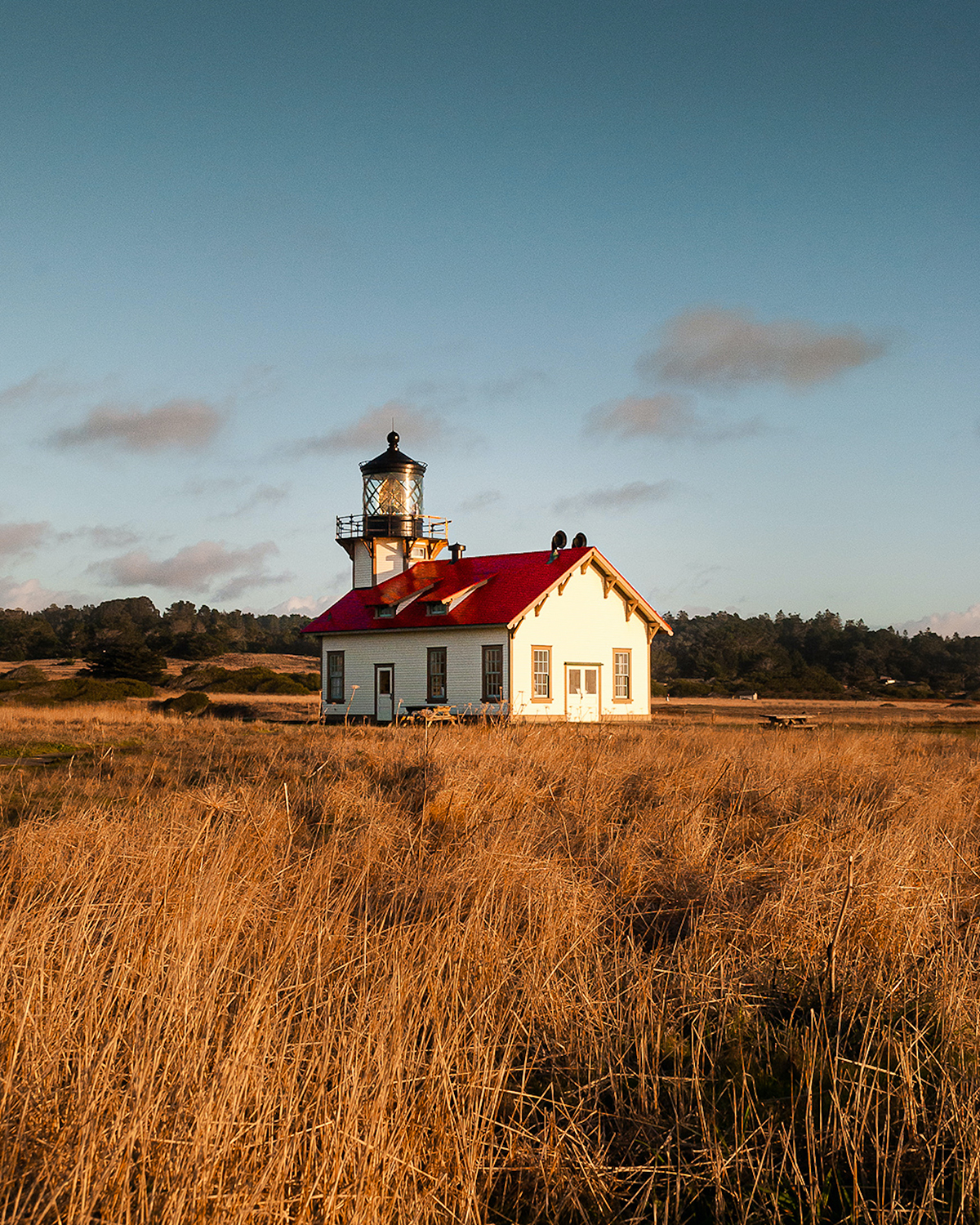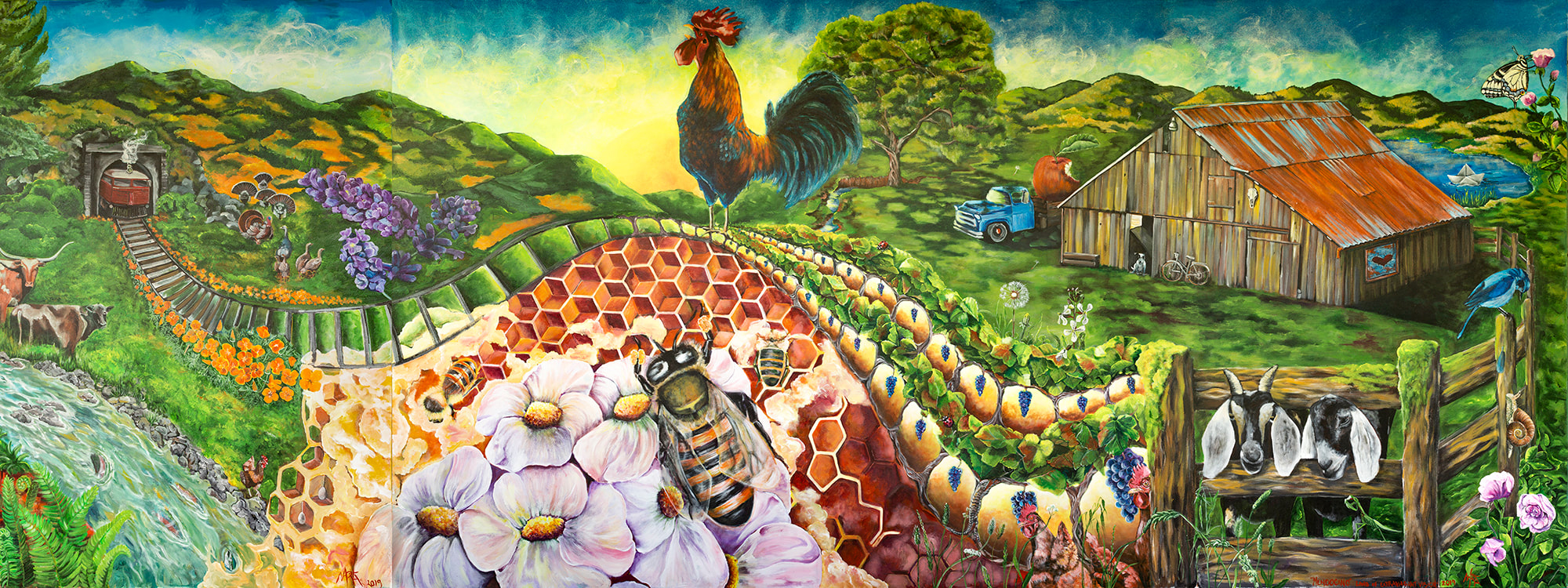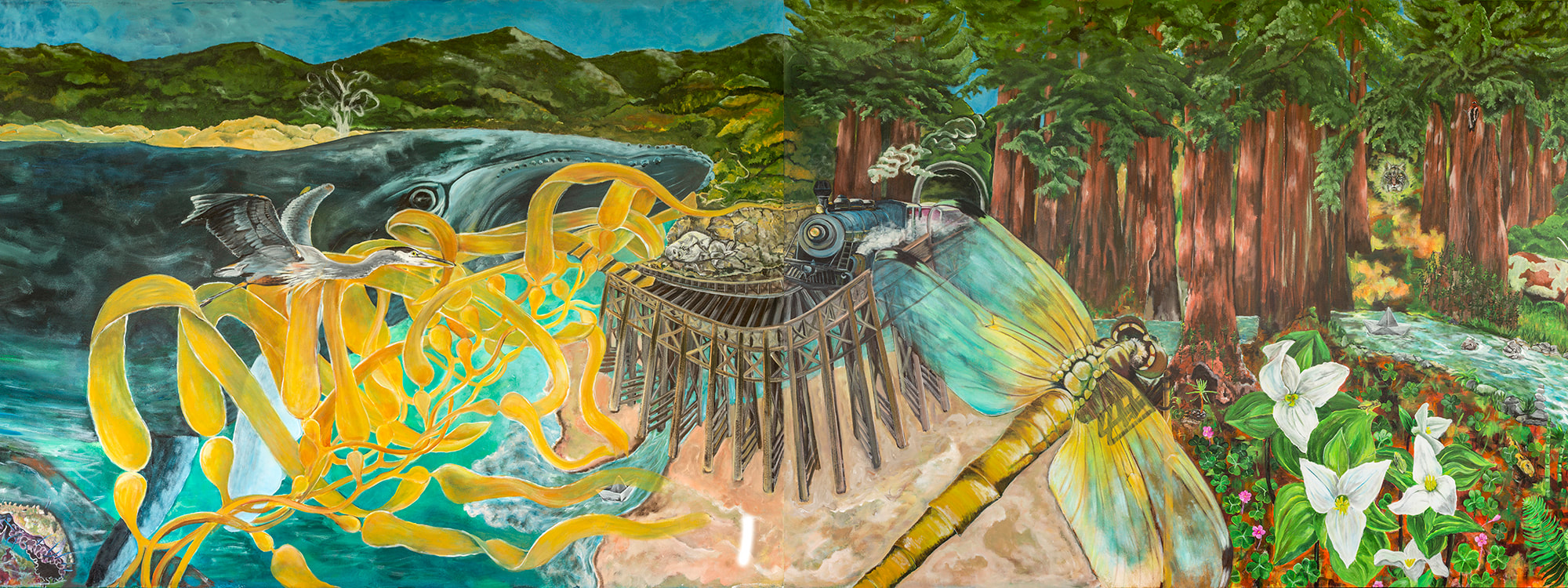Matsya and the Great Deluge
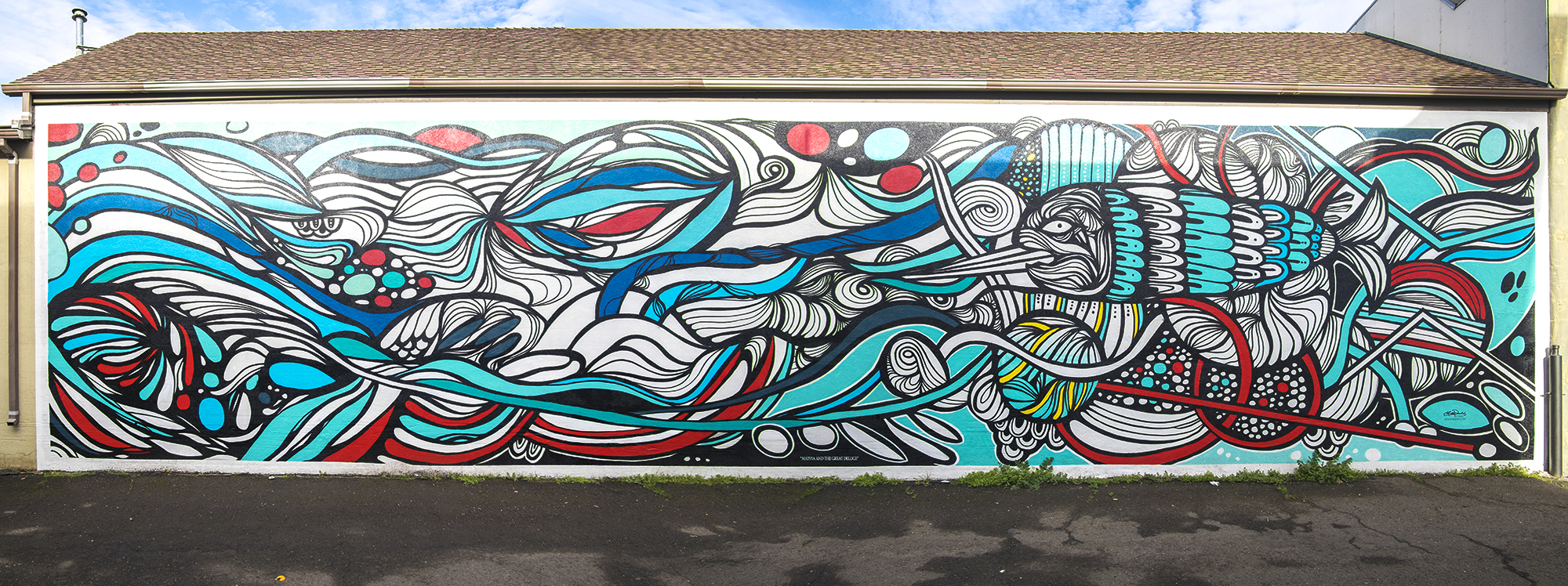
Title
Matsya and the Great Deluge
Artist: Bojh Parker
Location: The alleyway next to 345 North Franklin (Visit Mendocino Office)
The sheer scale of Bojh’s 15’x55′ mural is dizzying, in a great way. Stand in front of it, and you will be instantly drawn into the swirling patterns, colors and waves just like Matsya, the fish protagonist in the story that inspired this mural.
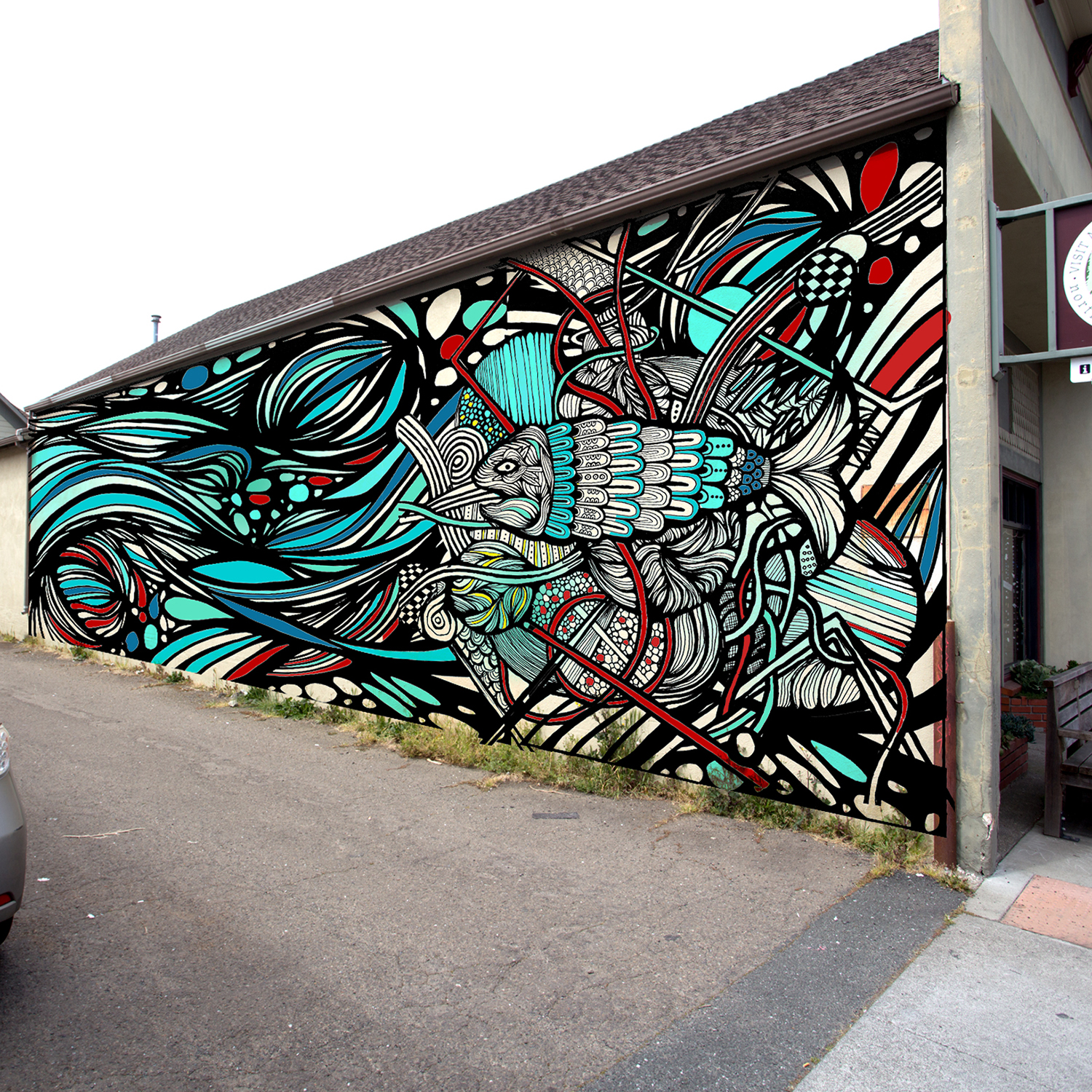
A computer mockup of the original proposed design…
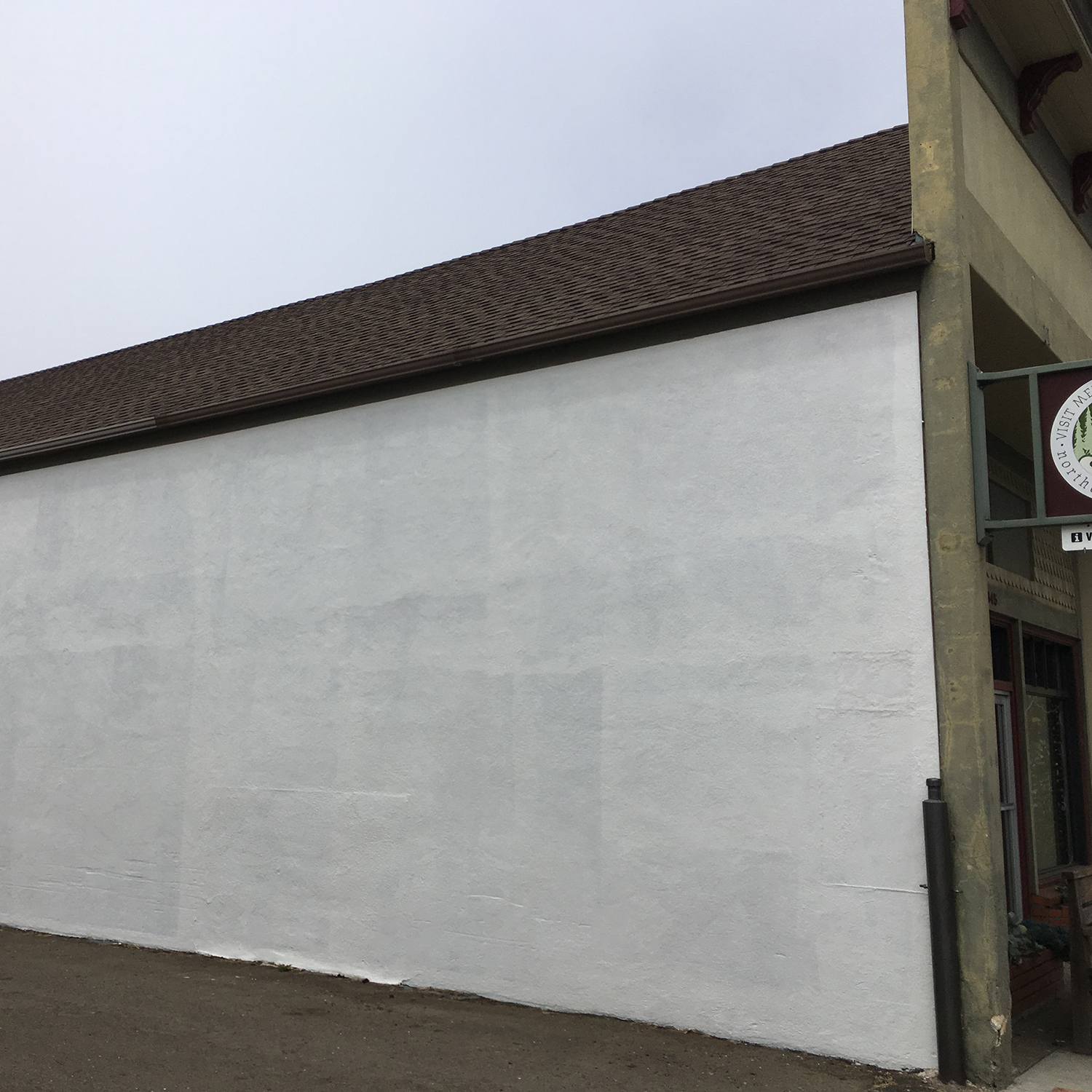
The blank canvas
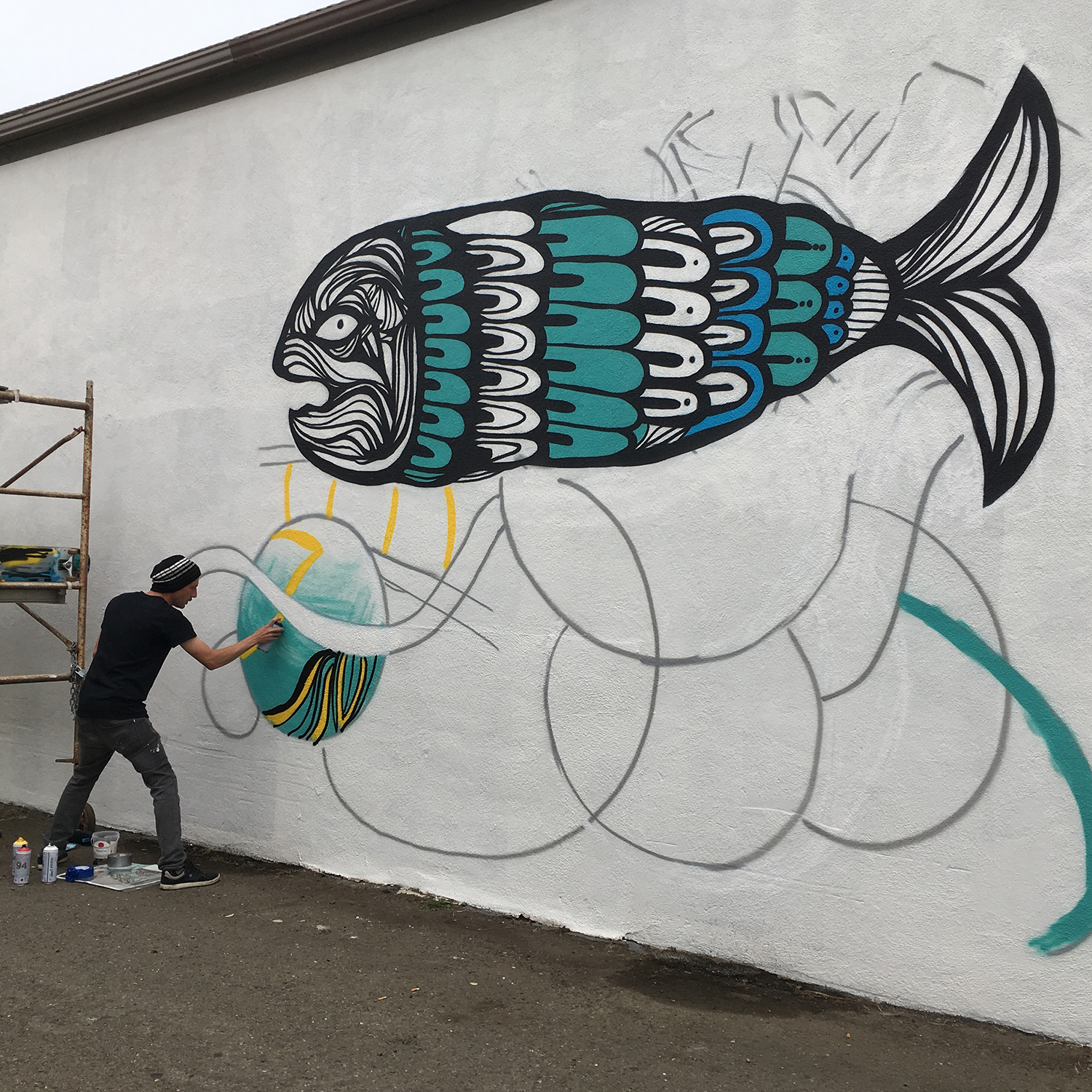
The work begins
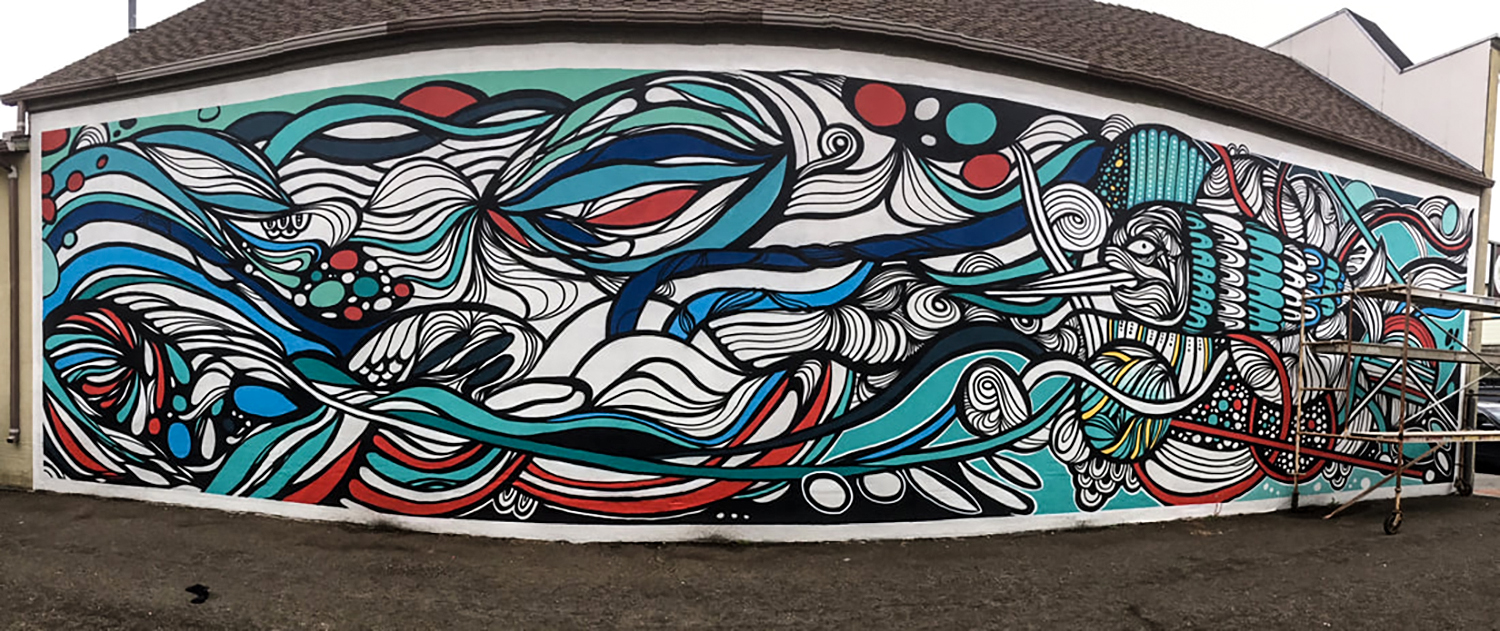
The completed final work… so big your eyes swim through it.
Inspiration for this installation
Matsya and the Great Deluge is an ancient tale from India retold in many texts starting around 700 BCE. Matsya is a small fish that appears to a great king named Manu, either in his wash bowl, or while he is performing religious rites by a river. Matsya begs Manu for protection from larger fish, and promises to save him from a great flood in the future. The king protects the small fish, transferring him to larger and larger containers of water as he grows. Eventually Matsya is so large that Manu puts him in the ocean. Matsya thanks the king for protecting him when he was small and vulnerable. He tells Manu the date that the devastating floods will arrive, and where the king should meet him with the great ship he must now go and build. On the day of the deluge Matsya finds the king and his ship among the swirling waters and tows him to the Himalayas where the king performs prayers and sacrifices, and re-establishes all life, thereby saving humanity and averting the complete destruction of the world. Pretty great, right?
How this installation came to be
Bojh Parker has an instantly recognizable style, so we were familiar with his work from other art shows around town. We were thrilled when he joined the Alleyway Art Project, and very impressed at his ambitious proposal for the very large wall that Alan Limbird volunteered for a possible public art space. Alan immediately pulled Bojh’s design out of the stack of proposals for the space. He later said, ” I immediately knew that was the one! Bojh’s mural really resonated with me. I didn’t look any further. I told Lia, this is the one. Let’s do it.” We have to admit, we were surprised, and impressed. It takes vision and courage to commit to such a bold design at that scale, but Alan has a sharp eye for talent, and he saw the potential in this proposal.Alan and Laura Limbird very generously offered to co-sponsor the mural. With Flockworks as a co-sponsor, a grant from The Mendocino County Tourism Commission, and some delightfully unexpected donations from members of the community and local businesses, we reached our funding goal and began planning the installation process. The finished work has exceeded everyone’s expectations. The mural has transformed the space, with locals and visitors alike regularly taking photos and chatting about “how they would describe this style of artwork.” To see more of Bojh’s work visit his website bojhparkermedia.com
If you want to commission a mural by Bojh you can inquire through his website contact page.
The story of Matsya and the king Manu, reminds us that sometimes if we protect small, delicate things from the “law of the jungle” where the strong gobble up the weak, the small things will have a chance to grow into mighty forces for good, that may someday save us all when we need it most. There are many real life examples of this story happening right now in Fort Bragg, from obvious examples like the local organizations working to restore our local rivers for salmon and trout, to less obvious examples like early childhood education programs, or if we may be so bold, the Alleyway Art Project, which started as a small “what if” and with the help of Flockworks and so many wonderful members of our community is growing into something far larger than we could have ever imagined.
Mendocino Land of Extravagant Visions

Title
Mendocino Land of Extravagant Visions
Artist: Marta Alosno Canillar
Location: Where the train tracks cross Main St.
This jewel of a mural is a love letter to Mendocino County. The flowing images layer many of Marta’s favorite, iconic bits of the county with details from her own life. You can stare at this mural for 20 minutes and still keep finding tiny surprises tucked into a corner or hiding behind a leaf. Here are a few of our favorite details:

Keen eyed observers may note that this honeycomb is hiding the symbol of the melatonin molecule. While Marta was painting this section she was listening to a podcast about the pineal gland, and the role of melatonin and seratonin in mental health and happiness. She hid the structure of the melatonin molecule in the honeycomb. Fun fact: Melatonin metabolizes into DMT, though not in high enough amounts to induce a psychoactive state. Bees are so important to any ecosystem, but particularly to a farm ecosystem. Marta likes making small things bigger and making big things smaller. She says “notice small creatures!”
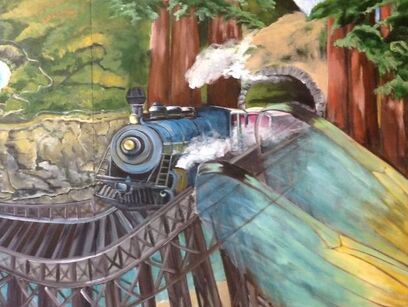
Marta was thrilled when the Skunk Train agreed to host this mural. Her grandfather worked for a train company and lived by depot in Spain. She has fond memories of traveling by train in Spain when she lived there, and she routinely travels by train when she visits. She particularly loved painting the engine.

Marta laughed when she described this section of the mural. She has spent years living in the country on a farm, farming and painting. She said somehow along the line she switched from farming to painting farms. This scene is a conglomeration of elements from her life. The bicycle was a gift given to her in high school by her parents for getting good grades. She later found it in her parents garage, packed it up and had it shipped to California. She loves that bike and rides it all the time. The dog by barn is her friend’s puppy. The puppy’s name is Dillinger, or Dilly.
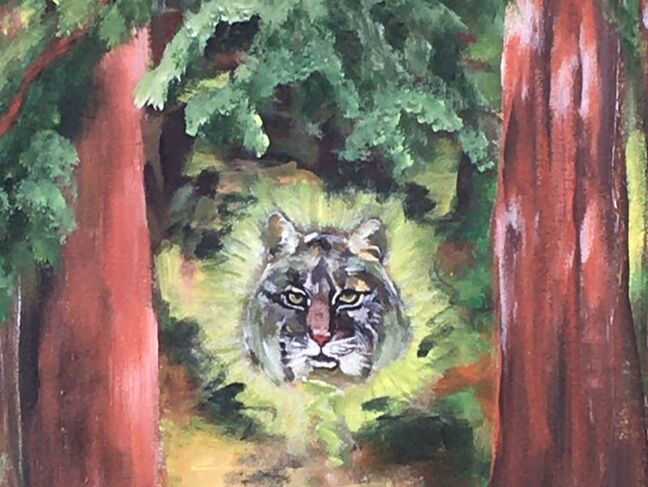
Are there really mountain lions in Mendocino? Yes there sure are. You are unlikely to see one however, and if you do, keep in mind that their preferred food is local deer, and there has not been a mountain lion attack since 1994. That being said, do not approach the mountain lion to try to get a picture. Seriously. Learn more here…
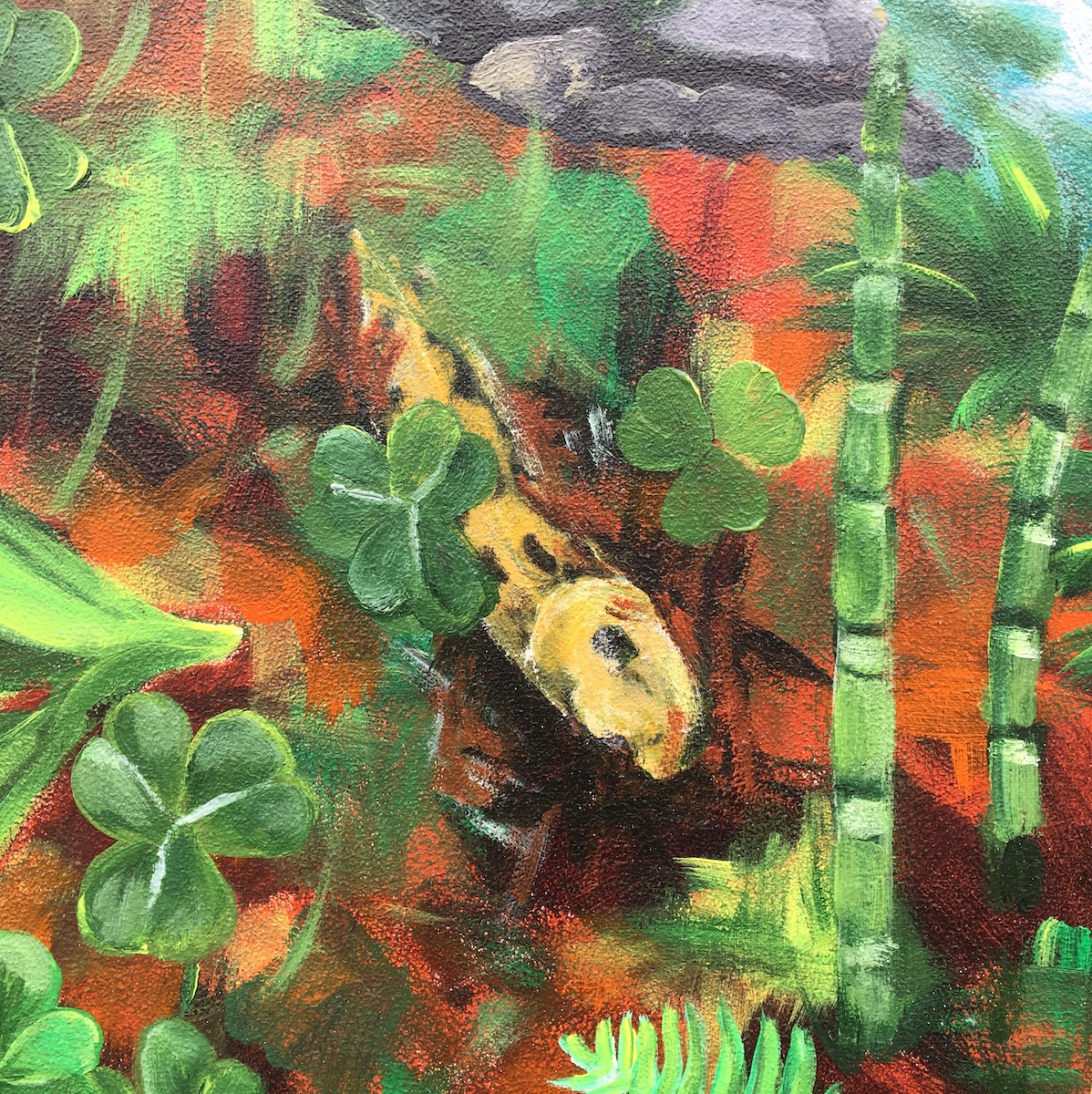
Hi banana slug! Banana slugs thrive in the damp shade of redwood forests along North America’s Pacific coastal coniferous rainforest belt (including douglas-fir forests and redwood forests) which stretches from Southeastern Alaska to Santa Cruz, California. They eat fallen leaves, mushrooms, moss, and other dead plant material. There are three species of banana slugs in California: the bright yellow California banana slug, the olive green and spotted Pacific banana slug, and the long thin Slender banana slug.
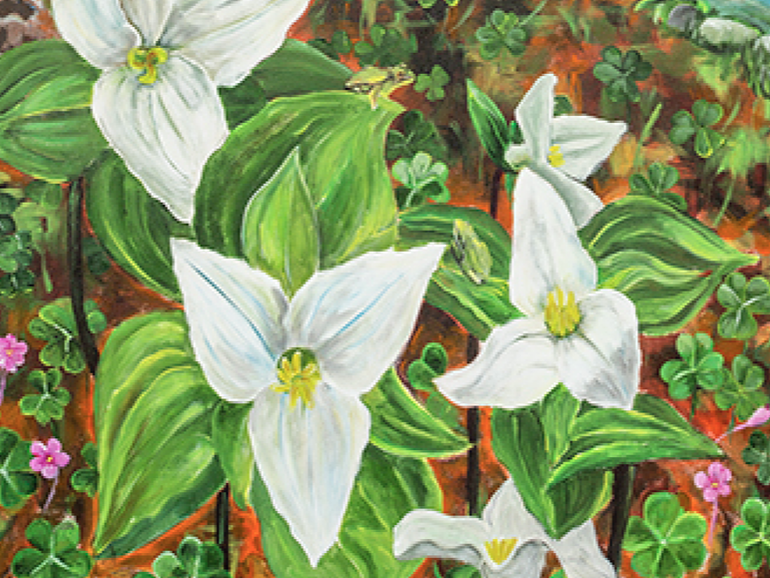
If you hike any of our local trails through the redwoods keep an eye out for two of our local plant species. Trillium ovatum flowers seem to glow white against the shady forest floor. Redwood sorrel is a common sight, distinguished by it’s red-backed clover-like leaves and pink flowers. Redwood sorrel has a bright, tangy, lemony flavor, but double check with a field guide before sampling anything in the wild. Did you notice the little frog sitting on the trillium leaf? Or the new Douglas fir sprout emerging from the fallen pine cone?
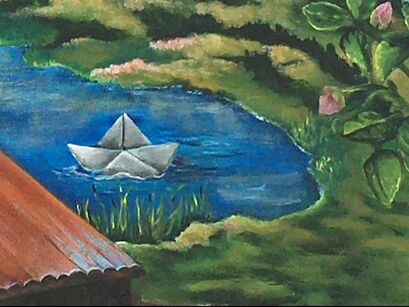
You may notice this little paper boat as it makes it’s journey from this inland pond to the sea.
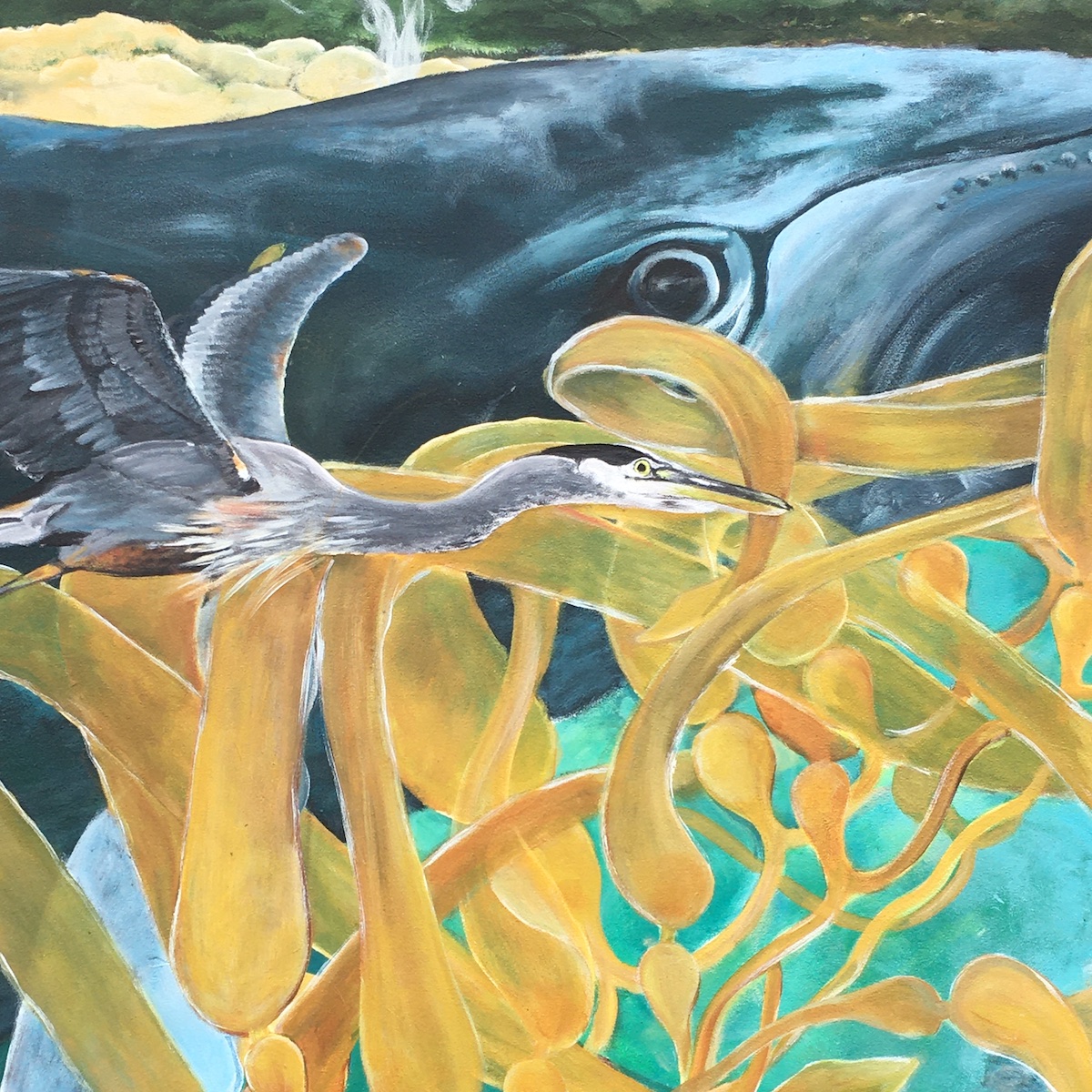
Since 2014 the vast forests of bull kelp off the coast of Northern California have experienced a catastrophic 95% die-off. Why? Learn more here…

Did you know that California’s wild turkeys are non-native? Learn more here…
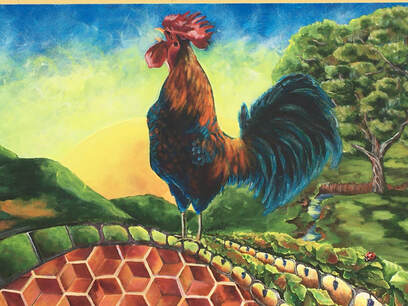
Chickens are dear to Marta. She says she loves chickens because they are very silly.
The North Coast
I’ve traveled to 48 of 50 states; my chosen home is the coast of Mendocino County, with its rugged
shorelines, majestic redwood forests, and snake-like roads. Wooden houses are the norm. Some are
vacation homes for millionaires, but most are cottages belonging to quirky people who’d choose to live
nowhere else. Farmettes exist with small populations of chickens, goats, or sheep. In this part of the
world, most everyone has (at the very least) a dog or cat. Sometimes, a potbellied pig or llamas.
By our Pacific headlands, seagulls swope, ospreys dive, and pods of pelicans fly by to everyone’s delight.
The ocean and rivers are home to playful otters and seals. And they contain delicacies: abalone, salmon,
mussels. If you are lucky, you might see a whale stealthily swimming their migratory route. It is their
water spout that gives them away.
Our forests draw wild animals, such as black bears and mountain lions. Ravens and heron build nests for
their babies in the treetops. Mule deer abound. Gray foxes venture out to find opportunities (such as
chicken houses).
When the Ft. Bragg Skunk Train returns from traversing the deep woods and modest mountains of the
coastal range, tourists clamber down its metal steps. The happy adults and children are off on more
adventures, the favorites being beach walks and seafood dinners. Locals are glad to have them arrive to
boost the economy, but they don’t mind when the visitors leave, and the streets become as quiet as the
fog.
By Susan Fisher
The Rhododendron


Title
The Rhododendron
Artist: Ferric Decay
Location: The shed next to the parking lot behind 300 North Main St.
This stunning piece was designed by local artist Ferric Decay and co-sponsored by local non-profit The Mendocino Coast Botanical Gardens. Their collection boasts more than 1000 rhododendrons, of 124 different species and 315 taxa. The flowers depicted in this installation are of the species “Pink Delight.” Peak rhododendron season is April to May, but you can see blooms from as early as December through June.
The Inspiration
Jacob, aka Ferric Decay, is a local artist, screen printer, and tattoo designer, often sought out for his moody naturalist style and lush details. He is currently setting up a tattoo shop in Point Arena, CA. While perusing his instagram feed, Lia saw a tattoo of rhododendrons that caught her attention. The Botanical Gardens loved the idea of a rhododendron installation downtown, both because rhododendrons are native to the moist redwood groves of Mendocino county, and because they host one of the largest and most spectacular rhododendron collections in the country, including many endangered species, some of which are now extinct in their native habitats. Everyone agreed the design would pair well with the weathered surface of a local shed commonly referred to as the “No Barking” shed, after a mischievous local changed the sign on the north side. Luckily the property owner agreed, and the Rhododendron was installed in April-May 2018.
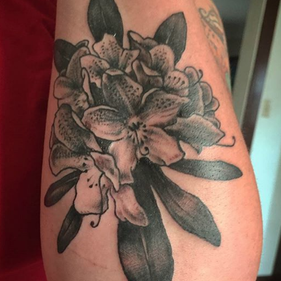
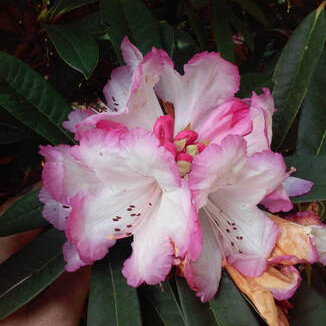
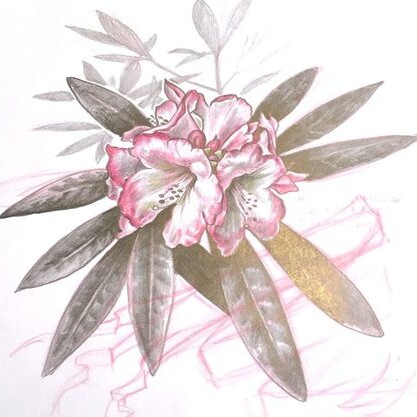
The Process
It took over a month to install the mural. Jacob started by projecting a sketch onto the side of the building at night and tracing it with charcoal. Then he removed all the previous paint in the areas the mural would cover. He was careful to leave the peeling paint on the rest of the building to preserve the weathered look. Oil based primers went on first, followed by tinted base coats, shadows, highlights, colors, and details, all building to create an image that appears to leap out at you from the side of the shed.
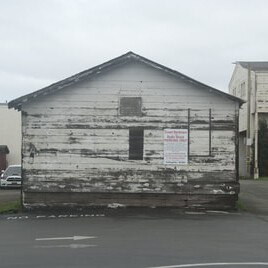

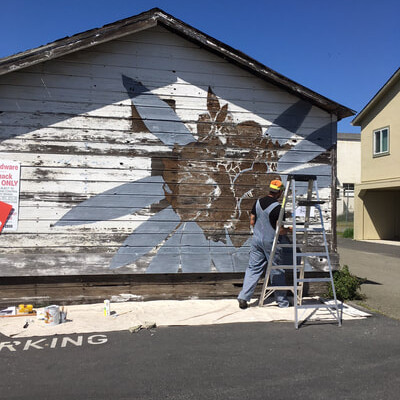
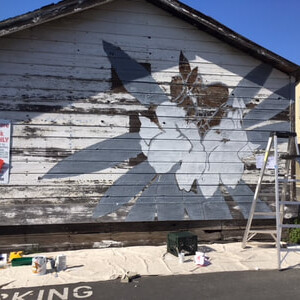

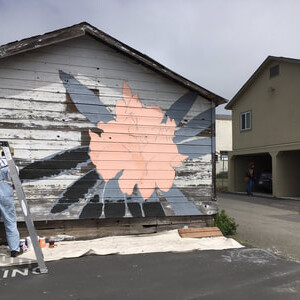
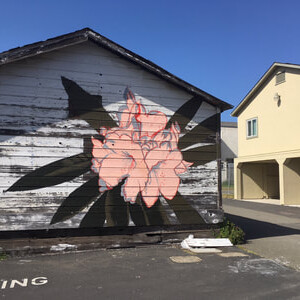
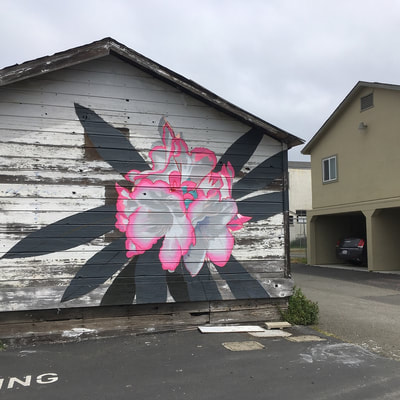
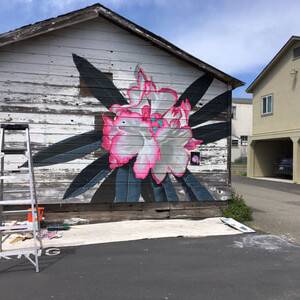
Rhododendrons on the Mendocino Coast
Tender species rhododendrons are found between 25- and 35-degrees latitude at elevations between 4,000 and 9,000 feet in their native habitats in Burma, China, and Tibet. In North America, only a narrow strip from Santa Cruz, California to Brookings, Oregon is suitable habitat for these plants. Mendocino Coast Botanical Gardens is close to the center of the optimal zone—the southern part of this strip is limited by low rainfall and restricted groundwater, while the northern section is limited by periodic extremes of cold. The lack of summer rain is offset by coastal fog and by the availability of irrigation water from local creeks.

Visit the Mendocino Coast Botanical Gardens
Mendocino Coast Botanical Gardens is a 47-acre nonprofit botanical garden that stretches from Coast Highway 1 to the Pacific Ocean and contains world-recognized plant collections. The Gardens was founded in 1961 by retired nurseryman Ernest Schoefer and his wife, Betty. Ernest’s keen eye spotted the ample supply of water augmented by the mild coastal climate and quality soil essential to acid-loving plants like Rhododendrons. In addition to rhododendrons, this botanical jewel has collections of fuchsias, magnolias, heaths, heathers, dahlias, heritage roses, mushrooms, succulents, camellias, and conifers. Specialty gardens include a perennial garden, woodland garden, and vegetable garden. Natural areas include riparian zones, shore pine and bishop pine forests, and ocean bluffs. The trails are great for both long and short walks (dogs welcome!). Visit www.gardenbythesea.org for more information.
Mendocino Botanical Gardens
Gates still open
a French blue sky
frames
purples and reds
yellows and whites.
The sunlight
cascades
over our shoulders
down our arms
pooling
on the black and white
fur of our girls.
This canopy of color
this quiet
late afternoon
broken only
by the sound
of the wind
and
the beat
of our hearts.
The gates close
the waning
gibbous moon
keeps watch
till a thunder
of rhododendrons
in bloom
ushers in sunrise.
– By windflower, 2022
Poetry and Prose generously donated by members of Writers of the Mendocino Coast. Learn more about this fantastic group!
Be A Light
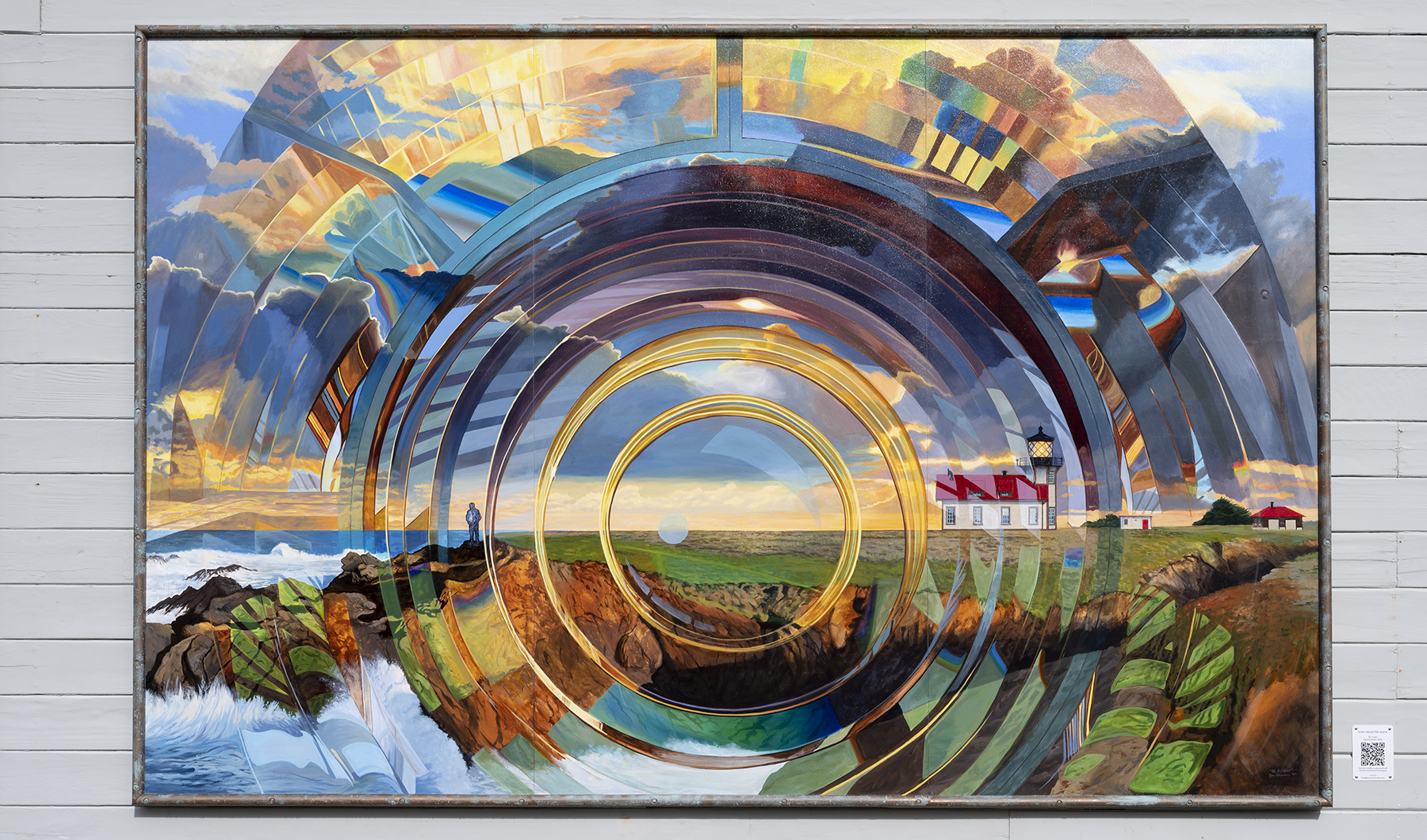
TITLE:
BE A LIGHT
Artist: Ryan Grossman
Location: The south-facing wall of 300 N Franklin St. (Along Redwood Ave.)
Ryan came to the Mendocino coast from San Francisco in 2015. He is a graduate of the Academy of Art University where he studied oil painting. Originally from the Pacific Northwest, he’s been heavily influenced by the visual power of seascapes and the increasing effects of climate change. His subtle narratives and symbolism drive his representational paintings often with a surreal or dreamlike quality.
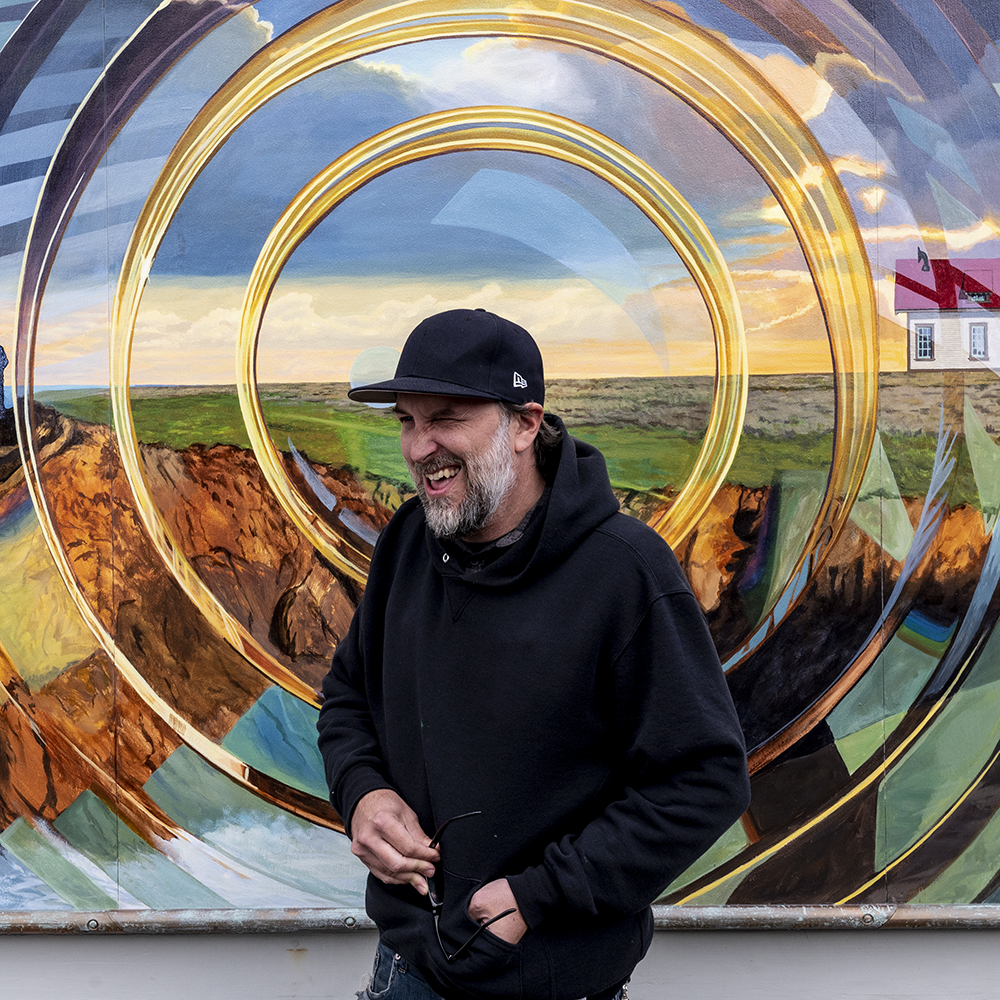

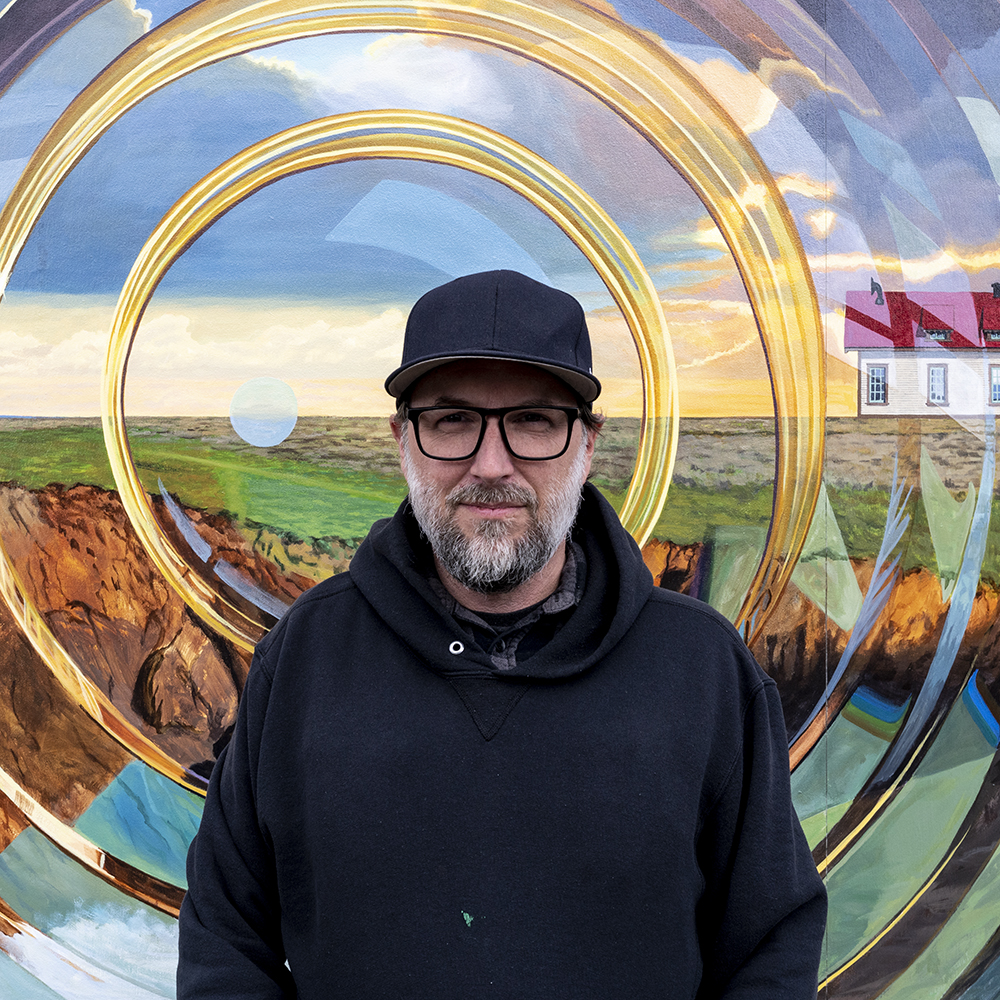
The Inspiration
The gift of this mural is intended to honor Ronald Reiter. He was in his element along the Mendocino coast and could stand for hours on a headland, taking it all in. He never missed a chance to visit a lighthouse, particularly those with Fresnel lenses. He was fascinated by their science and art. On a tour at the Mendocino lighthouse, he soaked up the volunteers’ words and enthused about the polished brass and circling prisms, his eyes reflecting the glow.He was, himself, a light in the world. He spent his career working to prevent companies from fleecing consumers. Here are some examples: He prosecuted cases against companies, among others, that lied and tricked low-income consumers into signing liens on their homes. He filed dozens of amicus and other appellate briefs with state and federal courts and occasionally the U.S. Supreme, for example, to insure companies exploiting their workers couldn’t falsely tout their fine treatment of workers in their ads. He lobbied the legislature, on behalf of the California Attorney General, to pass laws more protective of consumers, for example, to prosecute so-called foreclosure consultants, or to prohibit auto dealers from making misleading claims based on “invoice prices.” He helped consumer protection prosecutors and legal aid attorneys and private attorneys across the state to realize the potential in California’s consumer protection laws to make a difference for the public.
So his light still shines.
The mural’s radiance honors his light and reminds us that we, too, can be a light.
Artists Quote
“When I was approached about the subject of this mural being Point Cabrillo Lighthouse, I wanted to honor not only Margaret’s husband Ron and the lighthouse itself in the vastness of the Point Cabrillo headlands, but particularly the Fresnel lens while keeping the creativity, emotionality and personal perspective that I present in my work and how to convey that into the very public format of a mural.
By arriving at the composition of the Fresnel lens overlaying the landscape of the headlands, I invite the viewer of the mural to be both inside the light of the lighthouse as well as view the lighthouse they are within-thus creating a tension of placement and a suspension of reality and the symbolic opportunity to “be a light”.
I like to think of each panel representing Past, Present, and Future. The figure on the bluff with the universe emanating from within represents the light of the past and the light of Margaret’s husband Ron. The lighthouse, the beacon to the future; the light in the dark showing the way. The circular, focused center of the lens in the middle panel being the in-between, the cycle, the present.
I hope it not only inspires curiosity and awe of the lighthouse and headlands but also reminds viewers to be a positive force in the world, a light in the dark. Thanks to the Fort Bragg Alleyway Mural Project and Margaret Reiter for giving me this opportunity to explore and expand my creativity. “
The Point Cabrillo Lighthouse
The historic Point Cabrillo Lighthouse was first lit on June 10 of 1909, and continues to shine today with its original Fresnel lens. The Fresnel lens was invented in the early 1800s by French engineer Augustin-Jean Fresnel. His invention revolutionized the world of light technology and his lens became the gold standard for lighthouses across the globe. The Point Cabrillo Lighthouse features a third order Fresnel lens, made up of 150 individual prisms that work together to direct light into beams that shine out toward the horizon. The ten second flash from the lighthouse can be seen for more than 13 miles out to sea.
Point Cabrillo Lighthouse was established as a navigational beacon, providing a waypoint for the lumber schooners traveling north and south along the Mendocino Coast. Originally lit with wicks and kerosene, the lens now uses a 1000 watt halogen bulb as its light source, and is operated as an Active Aid to Navigation by the United States Coast Guard. The grounds at Point Cabrillo Light Station State Historic Park are maintained and managed through a partnership between California State Parks and the Point Cabrillo Lightkeepers Association, a 501(c)3 organization dedicated to preservation and education at the lighthouse.
The Point Cabrillo Light Station State Historic Park is located halfway between the towns of Fort Bragg and Mendocino, on Point Cabrillo Drive. The museums and gift shop are staffed by volunteers and are open every day of the year from 11am – 4pm. Learn more about Point Cabrillo by visiting www.pointcabrillo.org.
